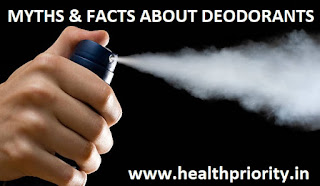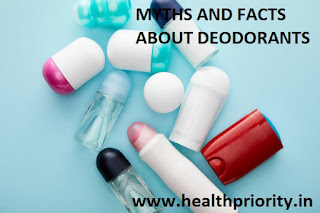Body odor is the matter of fact that usually affect your mood and image. Good body odor is the part of daily body acre routine. But are these deodorants good and safe to be used?
Well there are a lot of myths regarding usage of deodorants which need to be busted. Here We Go!!!
 |
| Myths And Facts About Deodorants |
Myth: Mostly deodorants are to be applied in the morning.
Fact: Deodorants, especially anti-perspirants are used to reduce underarm sweating, thus reduce keeping body odor fresh, with no stinking. When these anti-perspirants are applied at bed time, due to sleep, metabolism process slows down and thus sweats less. Due to which a more effective layer of wetness protection is formed in the underarms. Hence, you wake up in the morning and do another application of deodorants, extra freshness is felt. Of course, you can reapply the deodorants whenever needed throughout the day.
Myth: Deodorants helps to prevent the body from releasing toxins.
Fact: This is totally a misconception. Organ-Kidney and liver are the primary organs for removing toxins and byproducts of metabolism that release toxins in the urine. Sweat is not a biological pathway to release toxins from the body.
 |
| Myths And Facts About Deodorants |
Myth: Aluminum in deodorant is harmful.
Fact: Aluminum in deodorant actually causes yellowish stain on the clothes. There is no fact of any harm caused by aluminum (but may be some people are more sensitive to it). Though some deodorants are aluminum free. Discoloration usually occurs when the minerals(Salt) in the sweat come in contact with the deodorant ingredients, thus leaving yellowish stain.
Myth: Magnesium Hydroxide is safe in deodorants.
Fact: The PH of magnesium hydroxide is higher than baking soda., which means magnesium hydroxide is more irritating than baking soda. Hence not safe to be used as in deodorant. Also, baking soda is not safe to be used on skin as it has higher PH that makes your skin irritating and disturbs skin protective barrier. Using baking soda or magnesium hydroxide on skin also affects the microbiome which is a collection of bacteria that helps to keep skin healthy causing irritation, rashes, redness or burning.
 |
| Myths And Facts About Deodorants |
Myth: Deodorant are the detox Formula.
Fact: Firstly, Skin is not a detox organ. Its just a protective barrier to keep harmful substances out. Hence, there is no evidence that using deodorant on skin actually detox your body. In transition to this, anti-perspirant clogs the sweat glands at once, and later on you may start sweating more, which leads the bacteria to live on the skin and feet sweat leading to odor.
Myth: Skin sticks more while using deodorants.
Fact: Only thing that causes stickiness is how much deodorant applied, nothing to do with deodorants itself. Applying too much will absolutely cause your armpits sticky.
Myth: Deodorants causes burning sensation when you apply it after shaving.
Fact: Usually shaving is the quickest way to get rid off underarm hairs and shaving also removes the protective layer of the skin, making it sensitive and causes burning. To prevent this, you can apply a shaving foam or gel before shaving and use deodorant which are free of alcohol.
 |
| Myths And Facts About Deodorants |
Myth: Use of deodorants causes darkening of underarms.
Fact: In some cases, darkening of underarms is genetic. While in many cases, darkening of underarms are due to shaving, scratching and a skin condition called acanthosis nigricans. Deodorants with moisturizing properties, with no alcohol and parabens is the best for delicate underarm skin.
Most imp rumor: Deodorant (anti-perspirant) causes breast and Alzheimer's diseases. There is no evidence that the risk of breast cancer increases with the use of deodorants and Alzheimer's disease, said by cancer experts, including US Food and Drug Administration (FDA) and scientific committee on consumer safety.

ConversionConversion EmoticonEmoticon